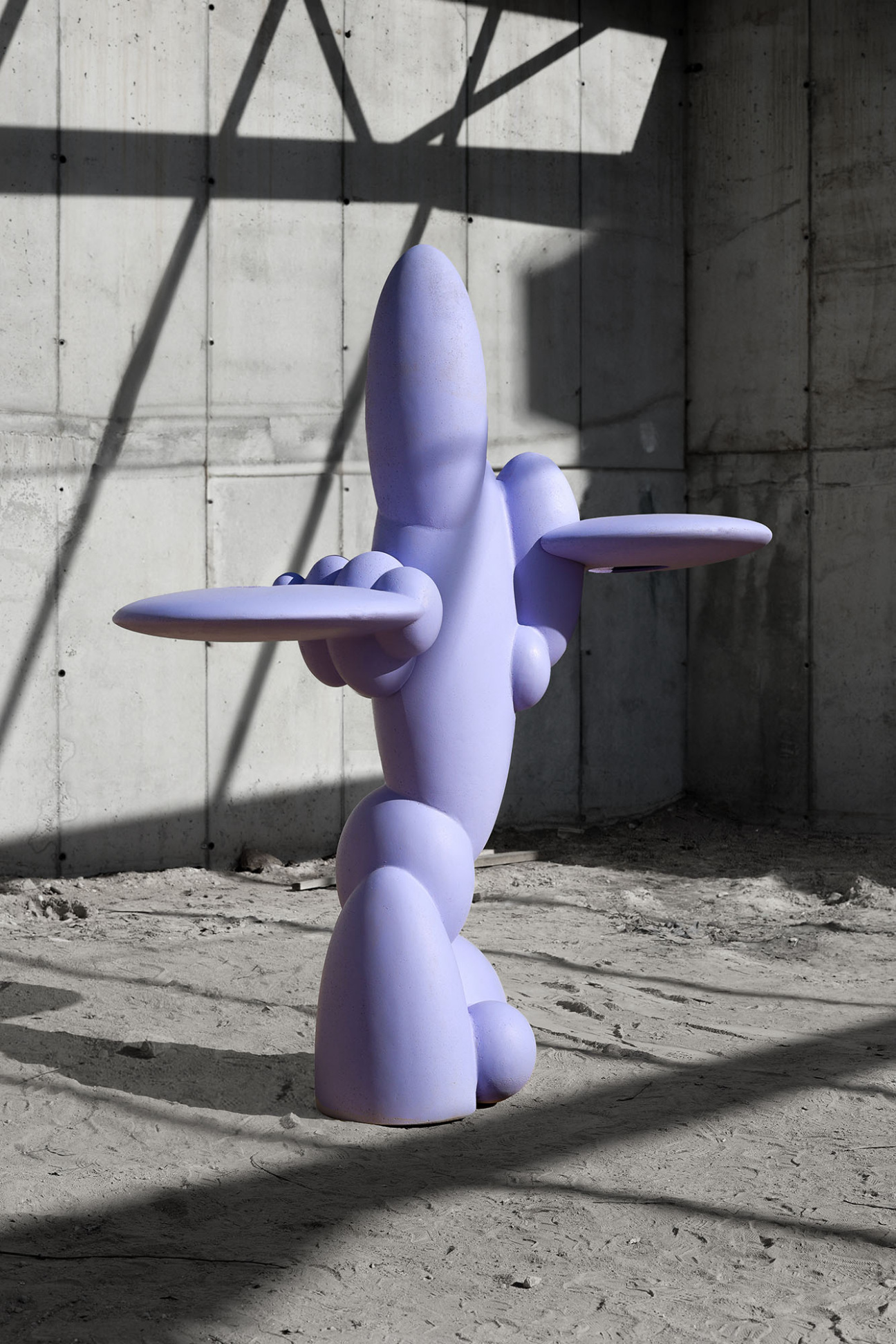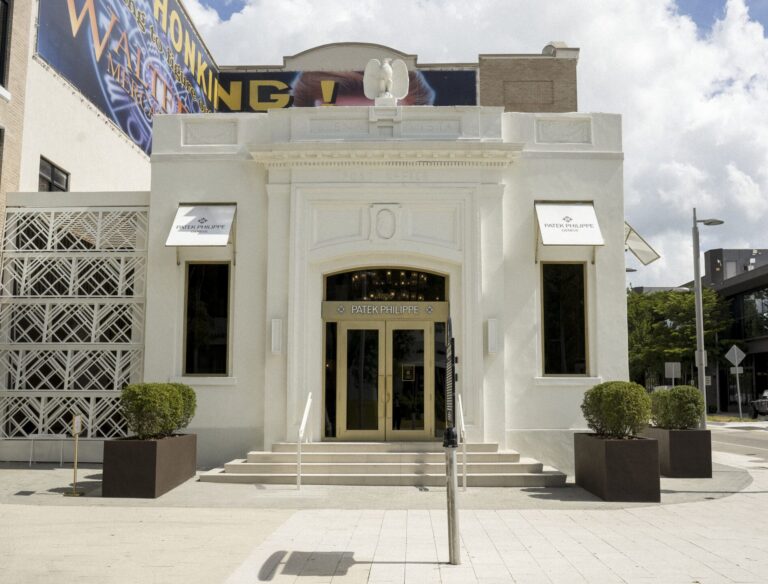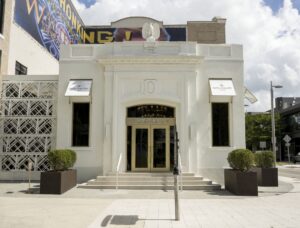
As the global art-circuit throng descends on Miami Beach for the annual weeklong alternate universe of fairs, parties, performances, and brand activations this December, Design Miami strives to provide some grounding context for the real-world impact that the furnishings and objects it showcases can have, not least in their power to prompt important questions.
Now in its 19th year, the fair returns to its tented quarters in Pride Park, steps away from the convention center and Art Basel Miami Beach, from Dec. 6-10. Curatorial director Anna Carnick conceived its theme, “Where We Stand,” to be “a celebration of design inspired by place, identity, and heritage,” says Design Miami CEO Jennifer Roberts. “It’s about exploring the role design plays both in reflecting and responding to the world around us, with a spirit of hope and optimism.”
Roberts, who steered the leading international design fair through the challenges of the pandemic, has expanded the online sales platform for galleries that was launched during Covid lockdowns, and inaugurated a popular new Paris edition of the fair this past October. She used that occasion to announce the acquisition of Design Miami by Basic.Space, a digital marketplace with a curated mix of vintage items, new limited-edition products, and exclusive brand collaborations.
“This next chapter offers a fantastic opportunity for us to continue to expand our offerings and reach an even wider audience, particularly among the next generation of great collectors,” says Roberts, who has clarified that Design Miami will remain independent. At this year’s Miami edition, visitors can expect a familiar feel to the 35 gallery booths and 14 Curio displays, the fair’s curated presentations of innovative design.

There are some notable first-time participants, including London’s Adrian Sassoon, Mumbai’s æquo, and Los Angeles’s Marta, which will show sculptural furniture-like objects by Nigerian designer Nifemi Marcus-Bello. Crafted in sand-cast aluminum at an autoparts foundry in Lagos, his richly textured works reference the dynamics of globalization and material supply chains as well as West African craft and ingenuity.
Materials will be the focal point of another first-time exhibitor, London’s Charles Burnand Gallery. Furniture made from hurricane-felled mahogany by Reynold Rodriguez will be joined by Jean-Gabriel Neukomm’s dazzling umbrella-shaped mica chandelier and Steven John Clark’s designs for his studio, DenHolm, their idiosyncratic forms hand-carved from limestone and then embellished with dyes and graffiti-like markings. “It’s all raw, honest materials that have been manipulated in unexpected ways,” says gallery founder Simon Stewart.
Returning Design Miami regulars include Friedman Benda, which has locations in New York and Los Angeles (and will open a third in Paris next year), Galerie BSL from Paris, David Gill Gallery and Gallery Fumi from London, and New York galleries Todd Merrill Studio, Magen H, and Cristina Grajales.
The latter’s garden-like booth will highlight Virginia San Fratello’s whimsical light fixtures composed of vivid, 3D-printed bioplastics with textures ranging from fluted to beaded to furry. “Intended to inspire intense happiness and pleasure,” according to the artist, the lights are an antidote to “the fear and darkness of the last three years, when many of us were afraid to touch things and to touch each other.”

Another fair stalwart, the Parisian Galerie Patrick Seguin, will bring its usual array of exceptional designs by French modern masters Jean Prouvé, Charlotte Perriand, Pierre Jeanneret, and Jean Royère. This year’s trove includes two rare Prouvé S.A.M. Tropique metal tables and one of his iconic aluminum panels with portholes.
The multi-city Carpenters Workshop Gallery, meanwhile, is using the fair to unveil a buzzy addition to its stable: the Haas Brothers. The prolific duo will show a group of playful animal figures rendered in exquisitely patinated bronze. The gallery’s booth will also spotlight the global influence of Dutch design, seen primarily through the lens of two celebrated gallery talents, Maarten Baas and Nacho Carbonell, whose “nonconformist mindset,” says director Ashlee Harrison, “echoes through the country’s singular artistic output.”
For those who missed the past year of shows at R & Company, the New York gallery will exhibit memorable standouts: Joyce Lin’s Exploded Chair, a selection of Roberto Lugo’s ceramics that mix traditional forms with references to hip hop culture and his Afro-Latino heritage, and Luam Melake’s Listening Chair, part of her series of robust geometric seating made with urethane-coated foam. Complementing the contemporary works, R & Company will also offer vintage designs by Joaquim Tenreiro, one of the Brazilian modernists who have long been a gallery staple.
If contemporary Brazilian furniture is your thing, the centerpiece of Mexico City– and New York–based AGO Projects’s Curio presentation is a group of carved wood and inlaid-wax pieces by the São Paolo–based Rafael Triboli. “The works have a wonderful hand to them, rendered in a language that’s rustic, masculine, even mystical,” says AGO cofounder Rodman Primack.

Design objects inspired by nature and created with organic materials are a mainstay at Sarah Myerscough Gallery in London, and they will take center stage in Miami, from Lin Fanglu’s landscape-like knotted, stitched, and pleated cotton-fiber tapestry to Nic Webb’s minimalist ceiling light carved from 250-year-old English oak.
Botanical artists Full Grown have contributed chairs shaped from living willow trees, while Diana Scherer manipulated the subterranean root systems of grasses to create silky, textile-like wall hangings. “These are artists who collaborate with the intrinsic intelligence of nature,” says Myerscough. “They integrate the artistic and romantic into the scientific.”
References to the natural world are also prominent in the work of artists exhibited by Hostler Burrows, which has galleries in New York and Los Angeles and is marking its 25th year as a leading champion of Nordic artists and designers. Notable highlights include a free-floating light object by Ane Lykke and a fanciful hand-crafted wall “rug” by Marianne Huotari, inspired by traditional Finnish weaving methods the artist has adapted using colorful ceramic beadwork. Huotari describes the piece as “a window to an idyllic escape—a mental landscape, an opportunity to dream, to seek change, and thus to grow.”

A similar spirit pervades this year’s Miami Design District designer commission, awarded to the London-based Lara Bohinc, whose installation Utopia will occupy public spaces throughout the neighborhood as well as at the entrance to the fair. Bohinc’s bulbous biomorphic seating, tables, and sculptures—made from environmentally friendly cork in pastel hues—suggest mushrooming amoebic organisms, their playful forms an invitation to gather and reflect.
“Design Miami is widely regarded as the premier collectible design fair in the world,” remarks Charles Burnand Gallery’s Simon Stewart. “Being included positions us at the forefront of the ever-evolving design landscape. In this setting, where it’s all about excellence and pushing artistic boundaries, every exhibitor knows they’ve really got to bring it.”










 in your life?
in your life?

